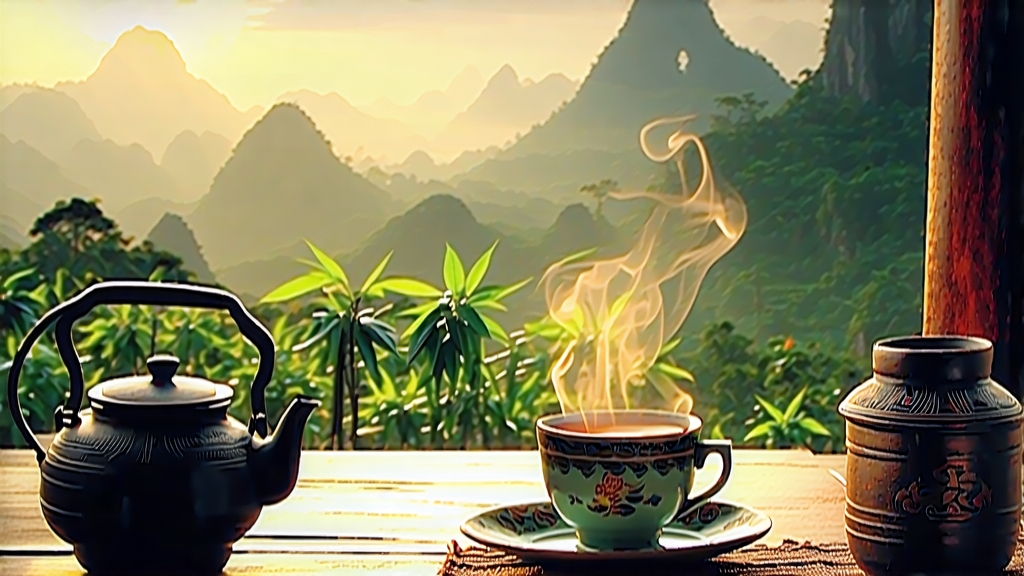
Liu Bao cha, literally “Six Forts tea,” is the quietest celebrity of China’s dark-tea family. While Pu-erh hoards the spotlight, Liu Bao has spent four centuries fermenting in the humid mountain air of Guangxi Province, emerging only when a caravan, a ship, or a homesick overseas Chinese needed a taste of nostalgia. To understand Liu Bao is to follow the West River downstream from the misty Da Wu Mountains to the once-rowdy port of Wuzhou, where bricks of rough leaves were lashed together, loaded onto bamboo rafts, and floated toward Hong Kong, Malaya, and the kitchens of grandmothers who would later swear that no dim-sum meal was complete without its earthy sweetness.
History: From Border Garrison to Maritime Gold
The name “Liu Bao” refers to six ancient stockades that guarded the mountain passes of Cangwu County during the Ming dynasty. Soldiers stationed there received compressed tea as part of their rations; the bricks withstood the southern heat and, to everyone’s surprise, tasted better after the long march. By the Qing Qianlong era (1736–1795), the tea had become tribute, and imperial edicts praised its ability to “cut grease, aid digestion, and sober the mind after wine.” When the British opened Hong Kong as a free port, Liu Bao sailed south with coolie laborers; in Kuala Lumpur’s tin-mining camps it was boiled in kerosene tins and sweetened with condensed milk, a humble brew that kept malaria and homesickness at bay. During the 1950s and 1960s, state-run Guangxi tea factories exported Liu Bao to Southeast Asia in square tins printed with red lanterns; those tins now fetch hundreds of dollars in Singaporean antique shops, proof that flavor can be a more faithful migrant than any passport.
Leaf and Place: Micro-terroir in the Da Wu Range
Liu Bao is made from a local large-leaf cultivar, Camellia sinensis var. sinensis f. pubilimba, whose leaves are broader, thicker, and more heavily veined than the Yunnan Da-Ye assamica used for Pu-erh. The bushes grow between 300–800 m on red lateritic soil rich in iron and aluminum; afternoon fog slows photosynthesis, increasing theanine and polyphenols. Farmers insist that three elements determine quality: the mountain’s “cloud cover days,” the West River’s humidity that drifts up-valley at dusk, and the occasional cold dew that forms when the first northern winds sneak past the Nanling Mountains in late October. The best plots face northeast, catching the morning sun but shielding the leaves from the scorching southwest summer heat.
Craft: A Dance of Water, Heat, and Microbes
Unlike Pu-erh’s sun-drying, Liu Bao undergoes a unique “pile-fermentation” invented in 1860 after a Wuzhou merchant tried to replicate the mellow flavor that naturally developed on long boat journeys. After plucking, the leaves are withered on bamboo screens for three to four hours, then wok-fired at 280 °C for eight minutes to kill green enzymes. While still hot, they are rolled into tight strips and piled 70 cm deep in a humid room kept at 28 °C and 85 % relative humidity. A spontaneous consortium of Aspergillus niger, Blastobotrys adeninivorans, and local Candida yeast species proliferates; over the next 20 days the pile is turned seven times, each turn releasing a sweet, almost over-ripe pineapple aroma. When the leaf core turns walnut-brown, the pile is broken, dried in a charcoal-heated oven at 60 °C, then steamed and pressed into 50 kg bamboo baskets called lang. These baskets are stacked in riverside warehouses where the cycle of humid summers and cool winters continues the fermentation for years, even decades.
Aging: The Bamboo Basket as Time Capsule
The lang is not mere packaging; it breathes. Thin bamboo slats allow micro-airflow, while the inner layer of banana leaf adds a faint grassy note. Over time, the tea absorbs the warehouse’s ambient microflora—spices from neighboring star-anise stores, smoke from joss sticks burned during the Ghost Festival, even the diesel exhaust of passing riverboats. Con